rezumat - Ion Ionescu de la Brad
rezumat - Ion Ionescu de la Brad
rezumat - Ion Ionescu de la Brad
You also want an ePaper? Increase the reach of your titles
YUMPU automatically turns print PDFs into web optimized ePapers that Google loves.
8.6.2.3. L’influence <strong>de</strong>s p<strong>la</strong>ntes-hote dans le développement <strong>de</strong><br />
l’espèce Cydia pomonel<strong>la</strong> L. --------------------------------------------------------------------- 151<br />
8.6.2.4. La diapause aux <strong>la</strong>rves <strong>de</strong> Cydia pomonel<strong>la</strong> L. ------------------------------------------------ 152<br />
8.7. P<strong>la</strong>ntes attaquées et <strong>la</strong> manière <strong>de</strong> nuire <strong>de</strong>s <strong>la</strong>rves <strong>de</strong> Cydia pomonel<strong>la</strong> L. --------------------------- 154<br />
8.8. Le combat intégré <strong>de</strong>s <strong>la</strong>rves <strong>de</strong> Cydia pomonel<strong>la</strong> L. ----------------------------------------------------- 154<br />
8.8.1. Métho<strong>de</strong>s physico-mécaniques ------------------------------------------------------------------------ 154<br />
8.8.2. Le combat biologique ----------------------------------------------------------------------------------- 155<br />
8.8.2.1. A l’ai<strong>de</strong> <strong>de</strong>s parasites ------------------------------------------------------------------------------ 155<br />
8.8.2.2. A l’ai<strong>de</strong> <strong>de</strong>s micro-organismes ------------------------------------------------------------------- 156<br />
8.8.3. Le combat chimique du ver <strong>de</strong>s pommes (Cydia pomonel<strong>la</strong> L.) ---------------------------------- 157<br />
8.8.3.1. L’efficacité <strong>de</strong> certains produits biologiques, pirétroi<strong>de</strong>s et organophosporiques,<br />
dans le combat <strong>de</strong>s <strong>la</strong>rves <strong>de</strong> Cydia pomonel<strong>la</strong> L., à (G1), à <strong>la</strong> Ferme Curteşti-2002 ---- 157<br />
8.8.3.2. L’efficacité <strong>de</strong> certains produits pirétroi<strong>de</strong>s, dans le combat <strong>de</strong>s <strong>la</strong>rves <strong>de</strong><br />
Cydia pomonel<strong>la</strong> L., à (G2), à <strong>la</strong> Ferme Curteşti–2002 -------------------------------------- 159<br />
8.8.3.3. L’efficacité <strong>de</strong> certains produits organophosporiques, dans le combat <strong>de</strong>s <strong>la</strong>rves<br />
<strong>de</strong> Cydia pomonel<strong>la</strong> L., à (G1), à <strong>la</strong> Ferme Curteşti–2002 ----------------------------------- 161<br />
8.8.3.4. L’efficacité <strong>de</strong> certains produits carbamiques, biologiques, mé<strong>la</strong>nges divers, dans<br />
le combat <strong>de</strong>s <strong>la</strong>rves <strong>de</strong> Cydia pomonel<strong>la</strong> L., à (G2), à <strong>la</strong> Ferme Curteşti–2002 --------- 163<br />
CHAPÎTRE IX. - LA PRÉSENTATION DES PRINCIPALES ESPÈCES DE<br />
L’ORDRE LEPIDOPTERA, LA FAMILLE ARCTIIDAE<br />
9.1. Hyphantria cunea Drury. (le papillon b<strong>la</strong>nc américain) -------------------------------------------------- 165<br />
9.2. L’Historique et <strong>la</strong> propagation <strong>de</strong> l’espèce ----------------------------------------------------------------- 165<br />
9.3. Le matériel et les métho<strong>de</strong>s <strong>de</strong> recherche ------------------------------------------------------------------- 166<br />
9.4. La <strong>de</strong>scription <strong>de</strong> l’espèce Hyphantria cunea Drury. ----------------------------------------------------- 169<br />
9.5. La biologie et l’écologie <strong>de</strong> l’espèce Hyphantria cunea Drury. ----------------------------------------- 169<br />
9.5.1. L’apparition <strong>de</strong>s papillons ------------------------------------------------------------------------------ 171<br />
9.5.2. Le rapport entre les sexes ------------------------------------------------------------------------------- 172<br />
9.5.3. Le rapport entre les exemp<strong>la</strong>ires <strong>de</strong> papillons tâchés et non-tâchés ------------------------------- 172<br />
9.5.4. La variation du poids et <strong>de</strong>s dimensions du corp <strong>de</strong>s papillons selon le facteur trophique ---- 174<br />
9.5.5. La copu<strong>la</strong>tion et <strong>la</strong> ponte -------------------------------------------------------------------------------- 177<br />
9.5.6. L’incubation (le développement embryonnaire) ----------------------------------------------------- 178<br />
9.6. Le développement <strong>la</strong>rvaire ----------------------------------------------------------------------------------- 179<br />
9.6.1. La nourriture <strong>de</strong>s <strong>la</strong>rves --------------------------------------------------------------------------------- 179<br />
9.6.2. La résistence à <strong>la</strong> faim <strong>de</strong>s <strong>la</strong>rves ---------------------------------------------------------------------- 179<br />
9.6.3. L’accroissement du poids et <strong>de</strong> <strong>la</strong> longueur <strong>de</strong>s <strong>la</strong>rves --------------------------------------------- 180<br />
9.6.4. La durée du sta<strong>de</strong> <strong>de</strong> <strong>la</strong>rve ------------------------------------------------------------------------------ 182<br />
9.6.5. Le retrait <strong>de</strong>s <strong>la</strong>rves pour se transformer en chrysali<strong>de</strong> --------------------------------------------- 182<br />
9.6.6. La mortalité <strong>de</strong>s <strong>la</strong>rves ---------------------------------------------------------------------------------- 183<br />
9.7. Le sta<strong>de</strong> <strong>de</strong> chrysali<strong>de</strong> (poupe) ------------------------------------------------------------------------------- 183<br />
9.7.1. La durée du sta<strong>de</strong> <strong>de</strong> chrysali<strong>de</strong>s ---------------------------------------------------------------------- 183<br />
9.7.2. La mortalité <strong>de</strong>s chrysali<strong>de</strong> ----------------------------------------------------------------------------- 184<br />
9.7.3. Parasites et prédateurs ----------------------------------------------------------------------------------- 184<br />
9.8. P<strong>la</strong>ntes attaquées et manière <strong>de</strong> nuire ----------------------------------------------------------------------- 188<br />
9.9. Le combat <strong>de</strong> l’espèce Hyphantria cunea Drury., dans les conditions <strong>de</strong> <strong>la</strong> ferme <strong>de</strong><br />
Curteşti-Botoşani, pendant l’année 2000 ------------------------------------------------------------------- 191<br />
9.9.1. Métho<strong>de</strong>s agrophitothecniques ------------------------------------------------------------------------- 191<br />
9.9.2. Métho<strong>de</strong>s physico-mécaniques ------------------------------------------------------------------------ 191<br />
9.9.3. Métho<strong>de</strong>s biologiques ----------------------------------------------------------------------------------- 191<br />
9.9.3.1. Le combat biologique par l’utilisation <strong>de</strong>s parasites ------------------------------------------ 191<br />
9.9.3.2. Le combat biologique par l’utilisation <strong>de</strong>s prédateurs ---------------------------------------- 193<br />
9.9.3.3. Le combat biologique par l’utilisation <strong>de</strong>s microorganismes entomopathogènes -------- 194<br />
9.7.4. Le combat chimique ------------------------------------------------------------------------------------- 196<br />
9.7.4.1. Le combat avec <strong>de</strong>s produits biologiques, pirétroi<strong>de</strong>s et organophosphoriques ---------- 196<br />
9.7.4.2. Le combat avec <strong>de</strong>s produits pirétroi<strong>de</strong>s ------------------------------------------------------- 198<br />
9.7.4.3. Le combat avec <strong>de</strong>s produits organophosphoriques <strong>de</strong> synthèse --------------------------- 200<br />
CONCLUSIONS ---------------------------------------------------------------------------------------------------- 202<br />
BIBLIOGRAPHIE -------------------------------------------------------------------------------------------------- 207<br />
6<br />
INTRODUCERE - Obiectul, importanţa şi oportunitatea cercetărilor privind biologia, ecologia şi<br />
combaterea integrată a principalilor dăunători din p<strong>la</strong>ntaţiile <strong>de</strong> măr<br />
Importanţa p<strong>la</strong>ntării mărului rezultă, în primul rând, în valoarea alimentară şi terapeutică a<br />
fructelor acestuia. Prezenţa acestor p<strong>la</strong>ntaţii constituie în ace<strong>la</strong>şi timp, un element <strong>de</strong> confort estetic şi<br />
foarte util pentru viaţa oamenilor, prin diminuarea poluării aerului din zonele un<strong>de</strong> sunt amp<strong>la</strong>sate.<br />
Printr-o anumită strategie adoptată <strong>la</strong> amp<strong>la</strong>sarea acestor p<strong>la</strong>ntaţii, <strong>de</strong> selectare a portaltoilor şi<br />
sortimentului a<strong>de</strong>cvat, lucrări <strong>de</strong> fertilizare, lucrările solului, tăierile <strong>de</strong> formare şi <strong>de</strong> fructificare etc. se<br />
urmăreşte asigurarea unui anumit potenţial <strong>de</strong> producţie.<br />
Acest potenţial <strong>de</strong> producţie poate fi diminuat cu 20-30% sau uneori compromis total din<br />
cauza atacului <strong>de</strong> boli şi dăunători. Prin urmare se impune în mod serios şi permanent protecţia acestor<br />
p<strong>la</strong>ntaţii, pentru a pune în valoare <strong>la</strong> cotele cele mai ridicate potenţialul <strong>de</strong> producţie al acestora.<br />
Perenitatea p<strong>la</strong>ntaţiilor <strong>de</strong> măr pe ace<strong>la</strong>şi teren, timp <strong>de</strong> câteva <strong>de</strong>cenii, fac ca lupta împotriva<br />
bolilor şi dăunătorilor să fie <strong>de</strong>stul <strong>de</strong> dificilă, comparativ cu p<strong>la</strong>ntele agricole anuale, <strong>la</strong> care rotaţia<br />
culturilor, constituie un mijloc foarte eficace <strong>de</strong> combatere.<br />
Numărul mare <strong>de</strong> dăunători care atacă în p<strong>la</strong>ntaţiile <strong>de</strong> măr fac ca organizarea combaterii<br />
acestora să ocupe un volum important din preocupările pomicultorului. Protecţia p<strong>la</strong>ntaţiilor <strong>la</strong> nivelul<br />
cerinţelor actuale, nu înseamnă numai salvarea recoltei, ci prin combatere este necesar să se realizeze<br />
mărirea procentului <strong>de</strong> fructe <strong>de</strong> calitate perfect sănătoase.<br />
În complexul <strong>de</strong> măsuri <strong>de</strong> combatere care să asigure sănătatea pomilor, un rol important a<br />
revenit în ultima vreme combaterii chimice, ca o consecinţă directă a progreselor realizare în ultimele 2-3<br />
<strong>de</strong>cenii în domeniul industriei chimice, care a pus <strong>la</strong> dispoziţia agriculturii numeroase produse<br />
farmaceutice cu eficienţă ridicată.<br />
Efectele foarte promiţătoare obţinute în combaterea unor insecte cu gra<strong>de</strong> <strong>de</strong> dăunare ridicate<br />
şi aparţinând din punct <strong>de</strong> ve<strong>de</strong>re sistematic <strong>la</strong> unităţi taxonomice diferite, au întărit opiniile <strong>de</strong><br />
universalitate în aplicarea noilor produse fitofarmaceutice. Însă tocmai aceste condiţii <strong>de</strong> intensivitate în<br />
aplicarea tratamentelor a condus <strong>la</strong> înmulţirea în masă a unor specii dăunătoare, cu implicaţii nebănuite.<br />
De aceea este necesar ca toate acţiunile <strong>de</strong> combatere să se aplice în concordanţă cu noul<br />
concept ecologic, al luptei integrate, care constă într-un sistem <strong>de</strong> reg<strong>la</strong>re a popu<strong>la</strong>ţiilor <strong>de</strong> dăunători,<br />
ţinând seama <strong>de</strong> zborul specific şi <strong>de</strong> dinamica speciilor <strong>de</strong> dăunători şi zoofagi, folosind în mod<br />
armonios toate meto<strong>de</strong>le <strong>de</strong> combatere (agrofitotehnice, fizico-mecanice, biologice şi chimice), pentru a<br />
menţine <strong>de</strong>nsitatea dăunătorilor sau atacul lor, <strong>la</strong> un nivel <strong>la</strong> care să nu producă pier<strong>de</strong>ri <strong>de</strong> recoltă.<br />
Acest sistem <strong>de</strong> combatere integrată (S.C.I.) reprezintă un ansamblu <strong>de</strong> meto<strong>de</strong>, mijloace,<br />
produse etc., care se aplică după criterii variate în cadrul tehnologiei <strong>de</strong> cultură pentru reducerea<br />
pier<strong>de</strong>rilor.<br />
Teza <strong>de</strong> doctorat abor<strong>de</strong>ază studiul principalelor insecte dăunătoare din p<strong>la</strong>ntaţiile <strong>de</strong> măr din<br />
ju<strong>de</strong>ţul Botoşani şi anume: Eriosoma <strong>la</strong>nigerum Hausm. (păduchele lânos), Quadraspidiotus perniciosus<br />
Comst. (păduchele din San José), Anthonomus pomorum L. (gărgăriţa florilor <strong>de</strong> măr), Cydia pomonel<strong>la</strong><br />
L. (viermele merelor) şi Hyphantria cunea Drury. (fluturele alb american).<br />
Teza îşi propune să aducă contribuţii <strong>la</strong> studiul acestor 5 specii din punct <strong>de</strong> ve<strong>de</strong>re sistematic,<br />
biologic, ecologic şi economic.<br />
De asemenea, să e<strong>la</strong>boreze o tehnologie <strong>de</strong> prevenire şi combatere integrată a acestora şi să<br />
facă recomandările pentru obţinerea unor producţii sănătoase, ridicate şi constante.<br />
Teza <strong>de</strong> doctorat este structurată pe 9 capitole, <strong>la</strong> care se adaugă o introducere, concluzii şi<br />
bibliografia. În total 219 pagini, cu 72 tabele, 20 figuri, 19 p<strong>la</strong>nşe şi 10 grafice.<br />
Coordonatorului ştiinţific Domnului Profesor consultant Doctor Filipescu Constantin, îi<br />
adresez şi pe această cale cele mai sincere mulţumiri şi toată recunoştiinţa pentru aleasa îndrumare<br />
ştiinţifică şi înalta competenţă profesională.<br />
Sincere mulţumiri şi tot respectul aduc membrilor comisiei <strong>de</strong> doctorat, care au avut<br />
amabilitatea să consulte teza şi să-şi formuleze opiniile.<br />
Aceleaşi mulţumiri aduc şi Domnului Profesor Doctor Georgescu Teodor şi Domnului<br />
Profesor Doctor Tălmaciu Mihai, celor<strong>la</strong>lte cadre didactice şi personalului auxiliar <strong>de</strong> <strong>la</strong> Catedra <strong>de</strong><br />
“Entomologie” pentru sprijinul moral, sugestiile <strong>de</strong>osebit <strong>de</strong> utile acordate, participarea <strong>la</strong> examamene şi<br />
susţinerea referatelor.<br />
Pentru sprijinul acordat prin participarea <strong>la</strong> examene şi susţinerea referatelor, mulţumesc şi<br />
Domnului Inginer Doctor Săpunaru Tănase - Cercetător principal <strong>la</strong> S.C.D.A. – Podu Iloaie.<br />
De asemenea, mulţumesc conducerii D.A.D.R. Botoşani şi colegilor <strong>de</strong> <strong>la</strong> Unitatea<br />
Fitosanitară Botoşani pentru înţelegerea acordată.<br />
Adresez şi familiei mele cele mai alese mulţumiri, care mi-a acordat tot sprjinul şi mi-au creat<br />
condiţiile favorabile pentru realizarea acestei teze <strong>de</strong> doctorat.<br />
... şi nu un ultim omagiu aduc fratelui meu Doctor Corneliu-Ioan Ungureanu care <strong>de</strong> acolo din<br />
“Lumea spiritelor” ne veghează - prima persoană care m-a <strong>de</strong>terminat şi încurajat să încep aceasta teză<br />
<strong>de</strong> doctorat şi tatălui meu Inginer Corneliu-Ioan Ungureanu...<br />
7



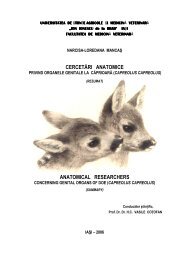
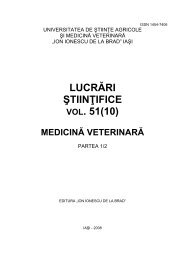
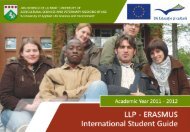
![rezumat teză [RO]](https://img.yumpu.com/19764796/1/190x245/rezumat-teza-ro.jpg?quality=85)
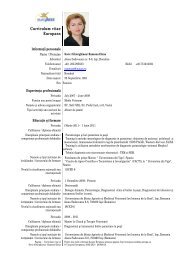


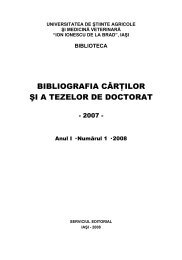
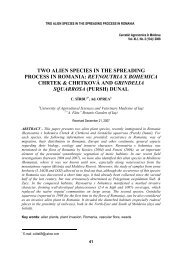
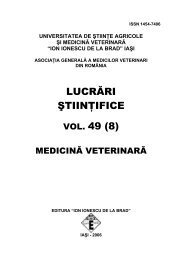
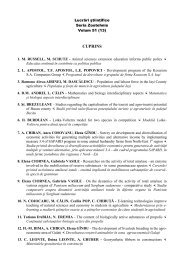
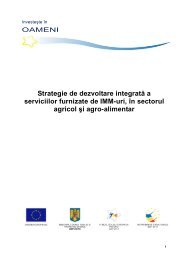
![rezumat teză [RO] - Ion Ionescu de la Brad](https://img.yumpu.com/14613555/1/184x260/rezumat-teza-ro-ion-ionescu-de-la-brad.jpg?quality=85)
